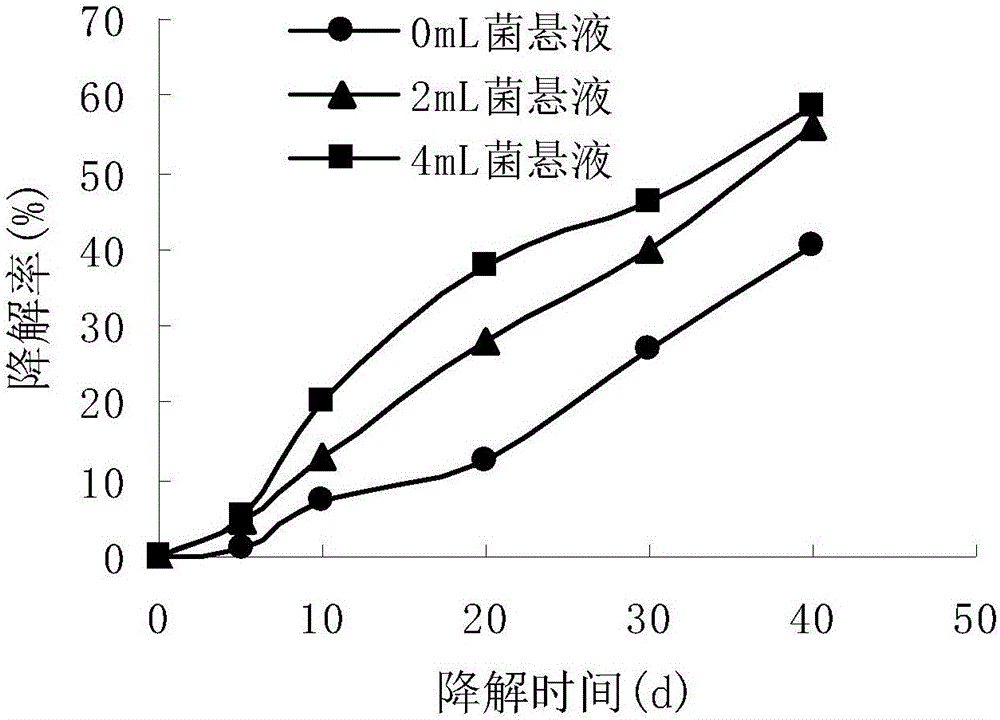Bacterial strain for degradation of 2,4,6-trichlorophenol and screening separation method thereof
A technology of trichlorophenol and separation method, applied in the field of degradation 2, can solve the problems of inability to meet the large-scale treatment requirements of chlorophenols, low purity of bacillus, low yield, etc., and achieves a simple method, high yield and high purity. Effect
- Summary
- Abstract
- Description
- Claims
- Application Information
AI Technical Summary
Problems solved by technology
Method used
Image
Examples
Embodiment 1
[0058] Collect the activated sludge in the internal circulation anaerobic reactor used to treat papermaking wastewater in a paper mill, measure 1L of semi-fluid activated sludge and add it to the domestication culture bottle, then add 1L of the domestication medium to adjust the pH to 7.0 , the acclimatization system after pH adjustment was enriched and acclimatized at 30°C in a strict anaerobic environment until the concentration of 2,4,6-trichlorophenol in the acclimatized system reached 800mg / L, and acclimatized sludge.
[0059] The domesticated sludge was inoculated in the solid screening medium supplemented with 8mg / L 2,4,6-trichlorophenol according to the dilution gradient, and three kinds of 2,4,6-trichlorophenol degradable Purified strains: A1, A2, A3.
[0060] The purified strains A1, A2, and A3 were respectively inoculated in the degradation medium supplemented with 90 mg / L 2,4,6-trichlorophenol. After testing, the degradation of the purified strain A1 to 2,4,6-tric...
Embodiment 2
[0062] Collect the activated sludge in the internal circulation anaerobic reactor used to treat papermaking wastewater in a paper mill, measure 1L of semi-fluid activated sludge and add it to the domestication culture bottle, then add 1L of domestication medium to adjust the pH to 7.2 , the domestication system after pH adjustment was enriched and domesticated at 40°C in a strict anaerobic environment until the concentration of 2,4,6-trichlorophenol in the domesticated system reached 800mg / L, and the domesticated sludge.
[0063]The domesticated sludge was inoculated in the solid screening medium supplemented with 12mg / L 2,4,6-trichlorophenol according to the dilution gradient, and five kinds of 2,4,6-trichlorophenol degradable Purified strains: C1, C2, C3, C4, C5.
[0064] The purified strains C1, C2, C3, C4, and C5 were respectively inoculated in the degradation medium supplemented with 110 mg / L 2,4,6-trichlorophenol. After testing, the purified strain C2 was resistant to 2...
Embodiment 3
[0066] The activated sludge in the anaerobic treatment reactor in the internal circulation of wastewater from a paper mill was collected, and 1L of semi-fluid activated sludge was added to the domestication culture bottle, and then 1L of the domestication medium was added to adjust the pH to 7.0. Fill the acclimatization culture bottle with nitrogen, and then seal the mouth of the acclimatization culture bottle with a rubber stopper with an air guide tube, so that the end of the air guide tube inside the bottle is inserted into the acclimatization system, and the end of the air guide tube outside the bottle is inserted into the sodium hydroxide solution Perform a liquid seal. The whole set of acclimatization device is placed in an anaerobic biochemical incubator for cultivation at 30-40°C. Transfer the culture to a solid medium supplemented with 50 mg / L of 2,4,6-trichlorophenol according to the inoculum size of 10%, and put it back into the anaerobic biochemical incubator to c...
PUM
 Login to View More
Login to View More Abstract
Description
Claims
Application Information
 Login to View More
Login to View More - R&D
- Intellectual Property
- Life Sciences
- Materials
- Tech Scout
- Unparalleled Data Quality
- Higher Quality Content
- 60% Fewer Hallucinations
Browse by: Latest US Patents, China's latest patents, Technical Efficacy Thesaurus, Application Domain, Technology Topic, Popular Technical Reports.
© 2025 PatSnap. All rights reserved.Legal|Privacy policy|Modern Slavery Act Transparency Statement|Sitemap|About US| Contact US: help@patsnap.com



